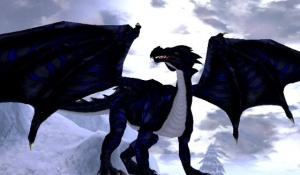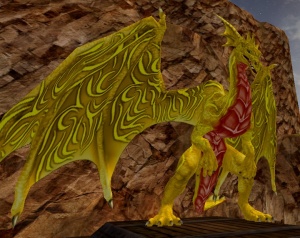Dragon
From Istaria Lexica
The Dragons are scaled, winged beasts capable of flight as they mature. They possess an unmatched raw strength, while possessing keen power and focus. Dragons have their own distinct schools.
General[edit]
The Dragons of Istaria are an enigmatic, ancient race whose existence predates the earliest of written records. In fact, a good deal of what is known about early Istarian history comes directly from sources the Dragons have shared with the other Living Races. Dragons have always held themselves outside the affairs of the other Living Races; only recently did both factions of Dragon society begin active cooperation with the "naka-duskael", or roughly translated as the "unscaled" in the Dragon tongue. Even amongst the Dragons, the necessity of survival will foster action outside the norm of their isolationism. This is quite the far cry from a race that many scholars believe were revered as deities in the times before the Age of the Gods.
Dragons themselves are quite alien when compared to the other Living Races physically, contributing to the solitary nature of the race. They are the largest of the races, with the eldest of the Dragons, the ancients, many times larger than the largest of the bipedal races. Dragons, once they reach a certain age, achieve the gift of flight; their enormous wings provide balance and some control in the air, but their ability to fly seems to be based more on their harnessing of external, mystical energies. Their skin is covered with thick scales, offering better protection than the majority of the armors the Living Races use. Dragons also have the natural ability to expel energy at a target by using their breath; most Dragons show an affinity with fire as their breath weapon of choice, though fire is not exclusively the energy used. The older a Dragon is dictates the potency and the variety of energy they might breathe. Dragons shun the use of conventional items and tools, relying more on their innate powers of magic to craft devices that suit their needs and to alter the environment around them. Dragons are also very possessive creatures; what a Dragon owns is of paramount importance to them. Dragons keep hordes of gold, resources, and items in secret caches only known to them; Dragons seem to be able to feed (in the figurative sense) off of the size of their horde, giving them added power.
Even with the distinct and unique nature of Dragon-kind in Istaria, there are certain realities of being that even the mighty Dragons cannot escape from. For hundreds of years, the Dragons have endured what outsiders call the Great Schism. In what is known of current Dragon society (the Dragons are not fond of openly sharing the details of their personal business with the world at large), there are two major factions: the Lunus and the Helian. The Lunus view themselves as the paragon of civilization, and that the other races should serve either to edify Dragon civilization (from a comfortable distance away), or they should simply get the heck out of the way. The Helian see themselves as the protectors of knowledge and the world at large; they feel the other races of Istaria could learn much from their example, and often inform them as much when they do decide to communicate. While other smaller factions have existed, these two represent the bulk of the mindset of their society.
While the differing philosophies of the factions at first never found themselves at odds, they began to clash when the maturing Living Races no longer feared and revered the Dragon-kind as they did in times past. The Lunus are typically the warriors of Dragon society; they felt that the other Living Races, especially the Humans, would eventually spell the downfall of the Dragons and wanted to take appropriate action to stop it. The Helians are more of the scholars and mages of Dragon society; they countered the Lunus by saying that they should take the lead in Istarian society, re-earning the reverence the other Living Races once had for them. The differences compounded between the factions, and over time became twisted as the inherent, unflattering draconic characteristics of possessiveness and greed twisted each side's view to the point that they found themselves at odds. Eventually, both factions became so disaffected with each other that unless immediate and drastic changes were made, the Dragons might turn on their own. The Helian acted first, choosing to relocate themselves away from their ancestral home so that they could pursue their agenda in peace. The Lunus were not happy with their society being torn asunder, but they did not move to stop the Helian; cooler minds realized that a civil war would certainly have spelled the doom that they had predicted would befall them all along.
Though the Dragons now have turned their attention to the continuing threat of the Withered Aegis and their Undead Hordes, the memories of the Great Schism are still fresh in their minds as though it happened yesterday. The Helian have an open dialogue (as open as dialogue with a Dragon can be) with the Humans, the Dwarves, and the free city of Tazoon. The Lunus have found it necessary on occasion to work with their neighbors in the mutual defense of their lands from the Undead Horde. The Lunus also share a dislike for the Humans with the Fiends, and their mutual dislike has fostered cooperation between them. The Dragons remain two distinct cultures to this day, and even though the menace of the Undead Hordes might force them to work together from time to time, there is little chance that the Dragons will reunite under a single banner anytime soon. Dragons are blessed with an unbridled strength, making them fearsome warriors. Dragons also strike a balance between power and focus, making them solid practitioners of the arts arcane.
Forms[edit]
As dragons grow, they pass through three different forms. Each form is optional for the dragon, and some choose to stick to one rather than move onto the next stage. It is purely personal preference, but the idea of being stronger or gaining an ability may also contribute to their choices.
Hatchling[edit]
The first stage is the hatchling stage - it is the one that all new characters spawn in. Hatchlings cannot fly, but they can glide. They are about the size of a human at eye level, but can vary depending on the scale. A hatchling cannot learn any of the breaths nor the epic spell Drulkar's Wrath. It can, however, enter Dralnok's Doom and grow to level one hundred.
Hatchlings are considered the weakest stage of dragon growth. They lack the ability to fly, and also are always two-hundred base health points off from adults, and four-hundred base health points off from ancients. (It can go below two/four-hundred if the hatchling has points added into the 'health' statistic, but the adult/ancient does not or has very little.) They also will be down points in strength as well, but it is not clear exactly how much.
The unique ability of hatchlings - gliding - is not available to adults or ancients. Adults and ancients can fly, but they cannot jump off a cliff and glide down like a hatchling can. Some players prefer to stay a hatchling simply for that.
Adult[edit]
The second stage is the adult phase. A hatchling must go through his/her Rite of Passage to ascend into an adult. The lowest possible level an adult can be is level thirty adventure and thirty crafting. Sixty crafting is required to be completely self-sufficient on the Rite of Passage.
Adults are the midpoint between hatchlings and ancients; able to fly but not as fast as an ancient can. They are also around two-hundred base health points less than an ancient dragon, but two-hundred higher than a hatchling. They also are stronger than hatchlings, but generally weaker than ancients.
They vary in size from somewhat larger than hatchlings to twice the size of a hatchling; almost the size of a New Trismus building. An adult can learn all of the dragon breath attacks, but it cannot yet learn the epic dragon spell Drulkar's Wrath.
Ancient[edit]
The last stage for dragons is the ancient phase. All dragons must pass through the adult phase and complete their Ancient Rite of Passage to ascend to this stage. The lowest possible level for an ancient is level one-hundred adventure and thirty crafting. However, you would need level one-hundred crafting to be self-sufficient for the Rite of Passage.
Ancients are the highest stage of dragon growth. They fly the fastest as well have two-hundred base health points over adults, and four-hundred over hatchlings. They have much higher strength stats as well. Ancients also gain a 110% base armor passive ability when they ascend.
The ancient dragons vary in size the most. The tallest ancient dragon is a head and a half taller than an adult, while the smallest is a fraction taller than one. (With the very commonly used Original Ancient Size Mod, the smallest ancients are a head taller than an adult, but the largest can be twice the size of one.) An ancient dragon can learn all the breath attacks as well as the epic spell Drulkar's Wrath.
|
Spoken Phrases, Utterings, Prayers, and Curses[edit]
Racial Cities[edit]More information[edit]Read more: |






